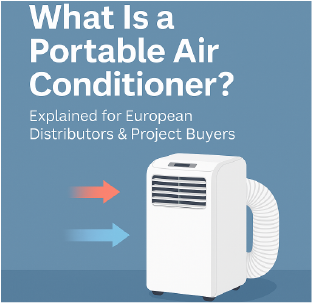Introduction
If you’re a distributor, wholesaler, or project buyer in Europe, you’ve likely come across portable air conditioners as a flexible and fast-growing solution for personal and light-commercial cooling needs. But what exactly is a portable air conditioner — and how does it differ from traditional air conditioning?
This guide breaks it down with technical clarity, compliance considerations, and B2B-ready insight.
Definition – What Is a Portable Air Conditioner?
A portable air conditioner (PAC) is a standalone air-cooling appliance that can be moved room to room and typically requires no permanent installation. It cools the air by removing heat and humidity, then exhausts the warm air through a flexible hose.
Ideal for locations where fixed AC systems are impractical, too costly, or time-restricted.

Inside a Portable AC – The Cooling Loop in Motion
A portable air conditioner operates as a closed-loop cooling system:
Air Intake → Room air is pulled into the unit
Heat Absorption → Refrigerant absorbs heat through the evaporator coil
Moisture Extraction → Humidity condenses and is either collected or drained
Heat Exhaust → Hot air is vented outdoors via hose
Cool Air Return → Processed cool air is blown back into the space
Bonus: Units with dual hose systems recycle indoor pressure better, making them more efficient for larger or sealed spaces.
Why Portable ACs Are Gaining Ground in Europe
Climate volatility: More frequent heatwaves in northern/central Europe
Historic buildings: Many cannot accommodate fixed ducting
Energy flexibility: Short-term rentals, Airbnb units, offices
No construction disruption: Great for healthcare, schools, and retail spaces
R‑290 refrigerant & ERP-compliant units available
Types of Portable ACs Available
| Type | Features | Best For |
|---|---|---|
| Single-hose | Basic, compact, affordable | Bedrooms, studios |
| Dual-hose | Better cooling & pressure balance | Larger rooms, high traffic areas |
| With Heat Pump | Cooling + heating (year-round use) | EU regions with cold winters |
| Smart AC (Wi-Fi) | Remote scheduling, energy optimization | Boutique hotels, modern offices |
What B2B Buyers Should Look For
BTU rating & room size fit (7k–14k BTU standard for EU indoor use)
Noise level (≤50 dB preferred) for hospitality and office spaces
Energy Label (ERP A++ or higher)
Compliance: CE, ERP, RoHS, EMC
Mobility & design: Swivel wheels, sleek housing, plug-and-play setup
Custom branding: White-label option for retailers or e-commerce sellers
FAQ – Is Portable AC Better Than Split AC in Europe?
| Split AC | Portable AC |
|---|---|
| Requires fixed installation | No installation – plug in & use |
| Higher cooling power (but less flexible) | Perfect for small rooms and rentals |
| Higher cost & maintenance | Budget-friendly, movable, compact |
How UnitedStar Supports European B2B Clients
Full-range portable AC units with R‑290 refrigerant
ERP, CE, RoHS compliant models
OEM/ODM packaging in EN/FR/DE/ES
MOQ friendly & fast sampling
Multi-market support: retail, e-commerce, leasing, hospitality
Conclusion
Now that you know what a portable air conditioner really is and how it fits into modern European spaces, the next step is choosing the right model for your portfolio.
[Send Inquiry to Get the UnitedStar Portable AC Catalog for Europe]
Whether you’re sourcing for summer promotions or year-round listings, we’re here to help.


